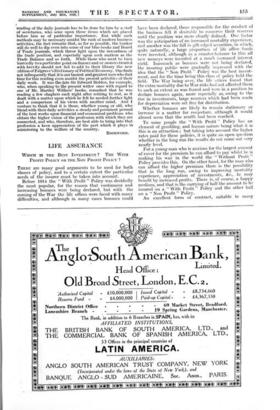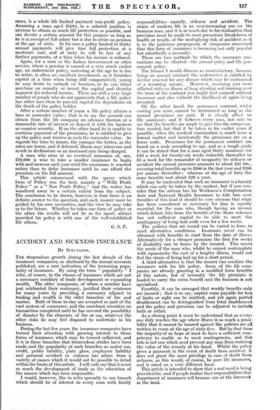LIFE ASSURANCE
WHICH IS THE BEST INVESTMENT ? THE WITH PROFIT POLICY OR THE NON PROFIT POLICY ?
THERE are many good arguments to be used for both classes of policy, and to a certain extent the particular needs of the insurer must be taken into account.
Before 1914 the " With Profit " Policy was decidedly the most popular, for the reason that continuous and increasing bonuses were being declared, but with the coming of the War the life offices were faced with many difficulties, and although in many cases bonuses could have been declared, those responsible for the conduct of the business felt it desirable to conserve their reserves until the position was more clearly defined. One factor was the anticipation of-an increased mortality experience, and another was the fall in gilt-edged securities,- in which, quite naturally, a large proportion of life office :funds were invested, although as a counter-balance to this all new moneys were invested. at a much increased interest yield. Inasmuch as bonuses were not being declared, the insuring public were gradually impressed with the idea that the Non Profit ' Policy was the best invest- ment, and for the time being this class of policy held the field. The War being over, the life offices found that the extra mortality due to War risks had not affected them to such an extent as was feared and were in a position to declare bonuses again, more especially as, owing to the rise in investments, large reserves which had been made, for depreciation were set free for distribution. Whether bonuses are likely to remain stationary or. increase is a matter for conjecture, although it would almost seem that the zenith had been reached.
To some people the " With Profit " Policy has an element of gambling, and human nature being what it is this is an attraction ; but taking into account the higher rates paid for these policies, it is quite an open question whether in the long run the results do not come out very nearly level. For a young man who is anxious for the largest amount of cover for the premium he can afford to pay whilst he is making his way in the world the " Without Profit " Policy provides this. On the other hand, for the man who can afford the higher premium there is the possibility that in the long run, owing to improving mortality experience, appreciation of investments, &c., he may benefit by increased profits. There is, of course, a happy medium, and that is the carrying of half the amount to be insured on a " With Profit Policy and the other half on a " Non Profit " Policy. An excellent form of contract, suitable in many cases, is a whole life limited payment non-profit policy. Assuming a man, aged thirty, in a salaried position is anxious to obtain as much life protection as possible, and can devote a certain amount for this purpose so long as he is in receipt of full salary but is due to retire on pension at the age of sixty. In his case a policy limited to thirty annual payments. will give him full protection at a moderate cost, and at sixty he will be free of any further payments, at a time when his income is reduced.
Again, for a man in the Indian Government or other service, where a pension is earned at a very much earlier age, an endowment policy, maturing at the -age he is due to retire, is often, an excellent ini,estment, as it furnishes Capital at a time when being still comparatively young he may desire to embark on business, or he can either purchase an annuity or invest the capital and thereby augment his reduced income. There are still a very large number of people who do not appreciate that a life policy has other uses than to provide capital for dependents on the death of the policy holder. After a certain number of years a life policy attains a loan or surrender value ; that is to say the assured can obtain from the life company an advance thereon at a reasonable rate of interest or deposit it with his bankers as counter security. If on the other hand he is unable to continue payment of the premiums, he is entitled to give up the policy and receive in cash the surrender value. As regards the time to insure, the younger the better, as the rates are lower, and if deferred, illness may intervene and result in declinature or an increased rate being charged. A man who aims at an eventual insurance of, say, £10,000 is wise to take a smaller insurance to begin with and increase each year until the maximum is reached rather than to defer insurance until he can afford the premium on the full amount.
This article commenced with the query which form of Policy was the best, namely a With Profit Policy" or a Non Profit Policy," and the writer has wandered away to a certain extent from the subject. The conclusion to be drawn, however, is that there is no definite answer to the question, and each insurer must be guided by his own necessities, and the view he may take as to the future. Whether he takes one form of policy or the other the results will not be so far apart, always provided his policy is with one of the well-established life offices. - G. S. P.



























































 Previous page
Previous page